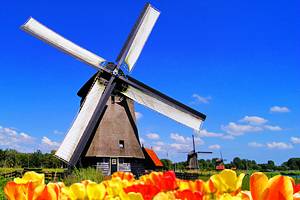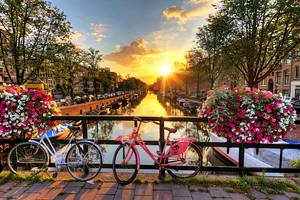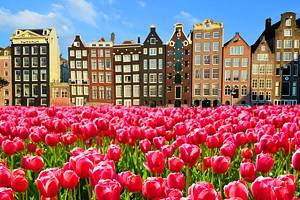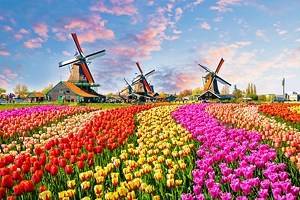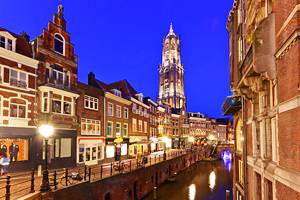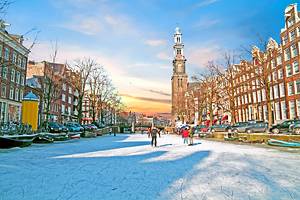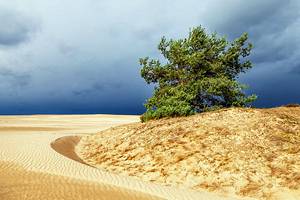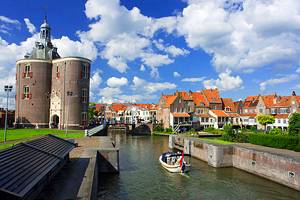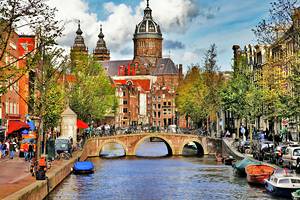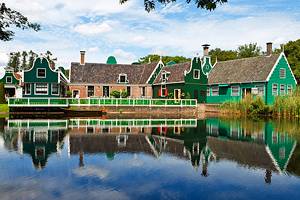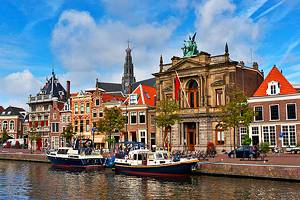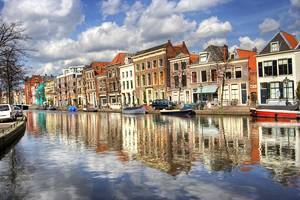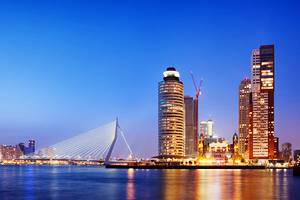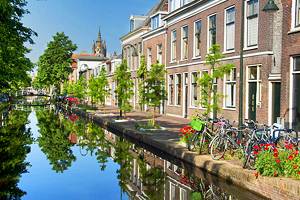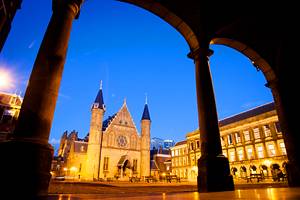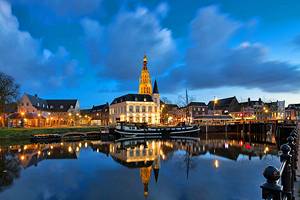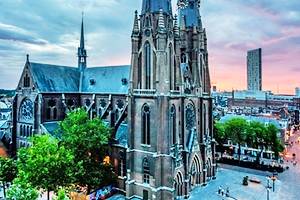Places to Visit in the Netherlands
The Netherlands is unique in Europe because so much of the land you see today was once ocean. The process of building the land up from the sea has given the Netherlands its most iconic feature: the windmill. Windmills, created to pump water out of areas retained by dikes, are today one of the most popular places to visit in Holland.
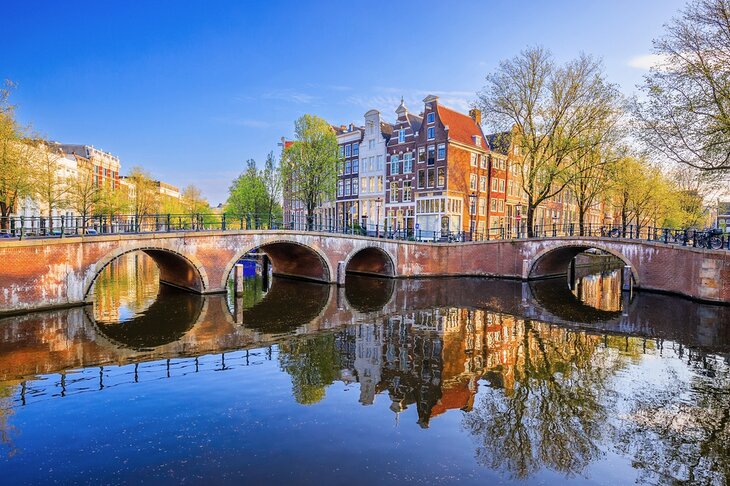
The Netherlands are full of iconic sites, with vast fields of brilliant tulips, canals that replace city streets, and dikes that today provide cycling paths. These are all attractions that tourists find fascinating in this little country.
This unique landscape has created an equally distinct culture, one that the Dutch are proud to share with visitors at their many museums and historic towns.
Plan your trip with our list of the best places to visit in the Netherlands.
Amsterdam
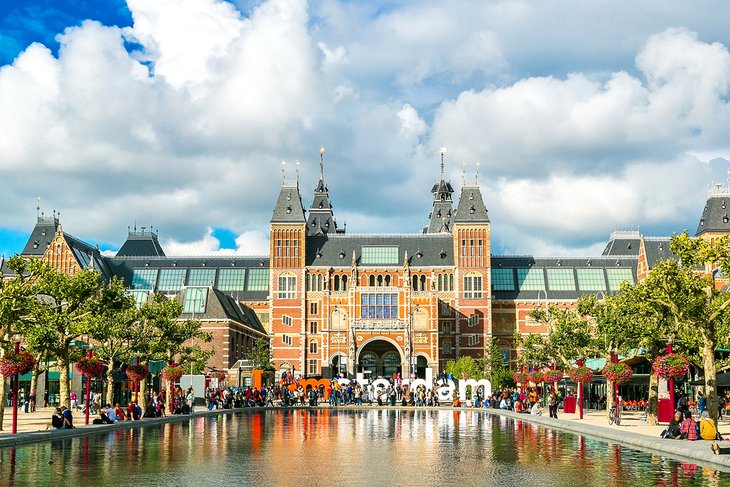
The capital city of the Netherlands, Amsterdam is one of Europe's best cities for arts, culture, history, dining, and pure scenic delight. Life in Amsterdam has a different pace, with vehicle-filled streets replaced by flower-adorned canals and motor-free avenues for pedestrians and cyclists.
One of the most famous sections of Amsterdam is the Jordaan neighborhood, its canals lined with restaurants and boutiques. It's also home to the open-air Lindengracht market on Saturday mornings, and Westerstraat bazaar-style market on Mondays.
People-watching is another popular thing to do in Amsterdam. One of the best places for this is Dam Square, lined with cafés and filled with popular attractions like the 17th-century Royal Palace (Koninklijk Palace), New Church (Nieuwe Kerk), and the National Memorial Statue. It's easy to spend hours here just enjoying the crowds and street performers.
Amsterdam is known for many things, but its museums are among the top attractions in the Netherlands, and for good reason. Arts and antiquities aficionados will appreciate the Rijksmuseum (National Museum), home to a massive collection that occupies over 250 rooms.
Art lovers will also want to visit the Rembrandt House Museum, located in the artist's former home. And, of course, the remarkable Van Gogh Museum is a must-see for admirers of this legendary painter. In addition to seeing some of his most famous works like Vase with Sunflowers and The Potato Eaters, you can also appreciate the immersive multimedia "Meet Vincent Van Gogh Experience."
No visit to Amsterdam is complete without a visit to the Anne Frank House, the actual home where Anne hid from Nazis during the occupation. Tourists can learn even more at The Resistance Museum (Verzetsmuseum), which explores the attempts to resist Nazi occupation. The Jewish Historical Museum is also in Amsterdam, with many religious artifacts on display.
Historic Haarlem
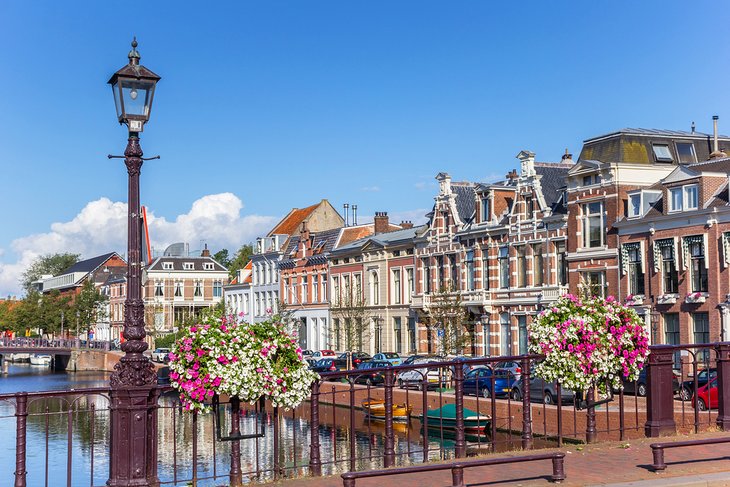
Located just a short distance from Amsterdam, Haarlem makes an excellent day trip from the city. The historic heart of Haarlem is centered around the Grote Markt, the main market square. The Old City Hall, constructed in the 13th century, is one of the most impressive buildings.
Nearby is the 14th-century Gothic church, St. Bavokerk (Grote Kerk). Both buildings have stunning interiors and feature impressive towers. In addition to a stunning interior and ornate furnishings, the basilica is home to the Müller Organ. This impressive instrument has 5,000 pipes and has been played by legendary musicians, including Mozart and Handel.
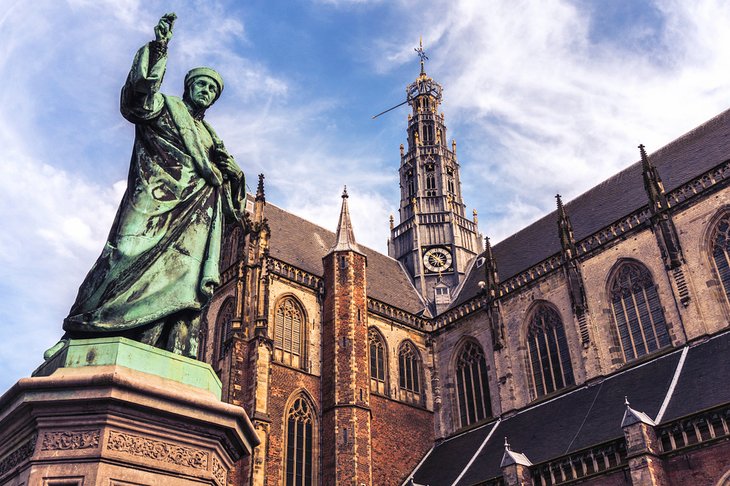
One of the most famous structures at the Grote Markt is the 1603 Vleeshal (Meat Hall) built in the Northern Renaissance style, now home to part of the Frans Halls Museum. The museum also occupies the ornate Vishal (Fish Hall), featuring the works of the Haarlem Academy artists, as well as examples of contemporary art, sculpture, and textiles by local creators.
Another top place to visit in Haarlem is the Teylers Museum, founded in 1778, which focuses on art and scientific achievements. Among its top exhibits are early scientific instruments, Michelangelo's figure studies from his preparations for the Sistine Chapel, and drawings by the artist Raphael.
If you're looking for areas to stroll during your sightseeing, head to the Bakenessergracht to see some of Haarlem's oldest buildings. When you get to the drawbridge at the River Binnen Spaarne, you will see the Amsterdamse Poort, the last surviving city gate, which was built in the early 15th century.
Grote Houtstraat is another street filled with historic buildings, and also quite a bit of good shopping.
Van Gogh Village, Nuenen
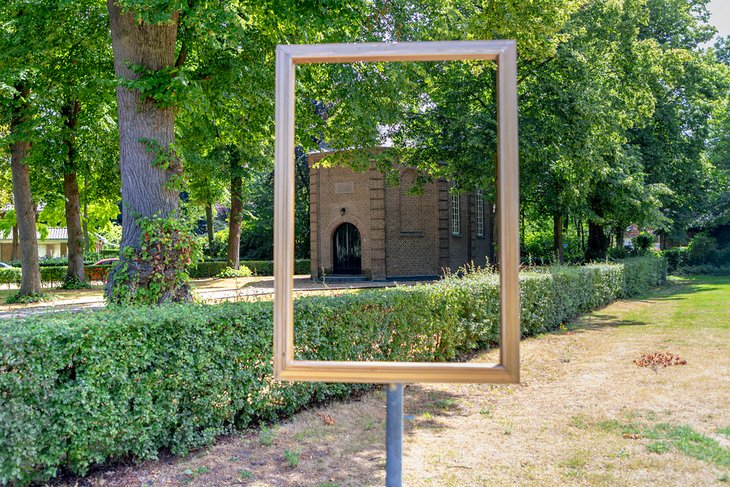
Just eight kilometers from Eindhoven is the village Nuenen, also known as Van Gogh Village. The artist lived here in a pastor's house from 1883 to 1885, and tourists can explore his former home, which has been lovingly restored. A self-guided tour visits nearly two dozen locations in the village that are connected to his time here.
The newly refurbished Museum Vincentre in Nuenen is an open-air museum that offers both self-guided and docent-led tours, which describe Van Gogh's time here, including his struggle with family relationships and the inspirations for his artwork.
There are numerous other statues and significant sites throughout the country, including the town of Etten-Leur, where his career as an artist officially began, as well as Zundert. Tourists will find informational kiosks with audio presentations at many locations associated with Van Gogh, so keep an eye out for them in your travels.
The Windmills of Kinderdijk
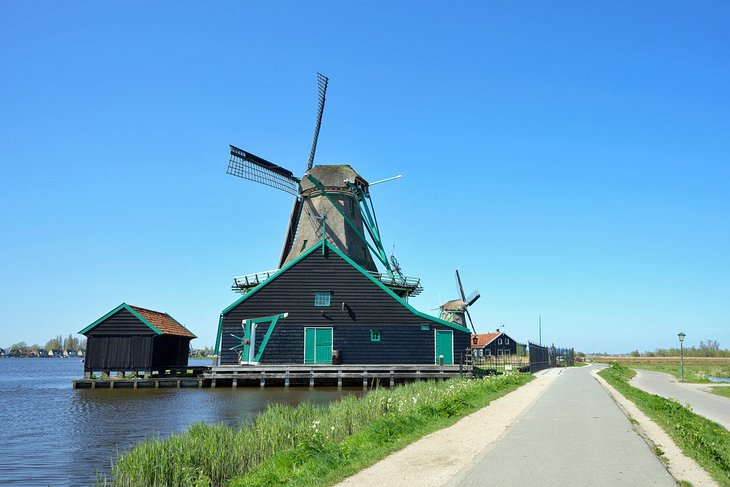
Near Rotterdam, beside the River Noord, sits the village of Kinderdijk, one of the most photographed places in the Netherlands. Here, visitors will find the country's largest collection of historic windmills, a total of 19, which were built between 1722 and 1761.
Unlike many other surviving windmills that were built to process grain and other materials, these were made as part of a water management system to keep the village from flooding. Each is a designated UNESCO World Heritage Site, and tourists can watch the huge sails spin on special "Mill Days."
Two of the mills are open to the public as museums, and the entrance ticket includes both of these, as well as a scenic cruise.
Museummolen Blokweer occupies the oldest of the windmills, built in 1630, and is unique because the entire top section can rotate to meet the wind.
The Museum Windmill Mederwaard was built in 1738, and is still furnished as it would have been when it was occupied by the Hoek family.
Leiden
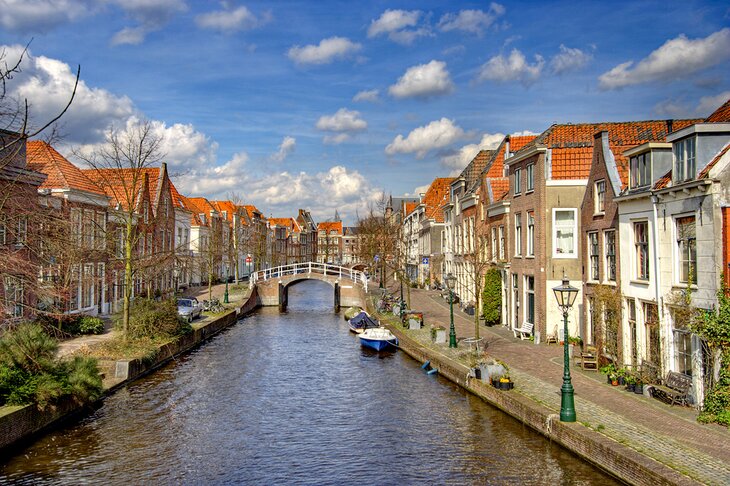
Leiden (Leyden) is a beautiful university town that is best known for its tulip farms and abundance of excellent museums.
One of the Netherlands' oldest remaining castles is Leiden Castle (Burcht van Leiden), built as a fortification in the 11th century. It has been a public park since the 17th century, but visitors can still see one of the original castle moats. Tourists can also walk the same route sentries once patrolled around the walls while enjoying spectacular views over Leiden.
Sitting atop a hill in Leiden is an imposing seven-story windmill that was originally used as a flour mill. This picturesque landmark was built in 1743 and is now home to the Windmill Museum (Molen de Valk). The museum includes the miller's quarters and the tools he once used, and tourists can learn about how the mill was operated and maintained. The museum also provides an in-depth look at the history and significance of windmills in the Netherlands.
Other top museums in Leiden include the Naturalis Biodiversity Museum (Nederlands Centrum voor Biodiversiteit Naturalis), which features a huge selection of natural history specimens, and Museum Boerhaave, which is associated with the nearby university and dedicated to the history of science and medicine. The National Museum of Antiquities is also located here, featuring artifacts from ancient Rome, Greece, and Egypt.
While in the area, visit nearby Duivenvoorde Castle (Kasteel Duivenvoorde), which was built in the 13th century. This grand palace features stunning grounds and numerous exhibits on the history of the property and the family that lived here for centuries.
Read More: Attractions & Places to Visit in Leiden
Delft
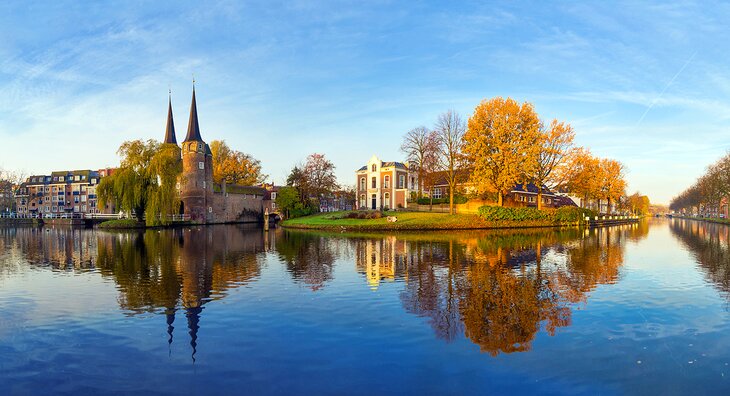
The historic city of Delft is best known as the home of Royal Dutch Delftware, a delicate blue-and-white pottery that has been made here since the 1600s. The last manufacturer, De Porceleyne Fles, is open for tours that allow visitors to watch the artists work on the hand-painted porcelain; you can also sign up for workshops to learn the technique yourself.
While in Delft, be sure to take a moment to see the Rose Windmill (Delft Windmill de Roos), a beautifully preserved corn mill that was built in 1679. Adventurous tourists can climb its seven stories via a ladder to get amazing views of the city below, and on Saturdays, you can see the mill in action.
Churches: Delft is also home to two stunning examples of Gothic churches. Oude Kerk (Old Church) was built in 1250 and features a 75-meter Coastal Gothic tower that was added in 1450. It is best known for its slightly tilted tower and a pyramid-shaped roof cornered by four turrets.
Construction on Nieuwe Kerk (New Church) was begun in 1396 and continued through 1486. The church sits overlooking Market Square (Markt), and its 108-meter Gothic tower provides an excellent vantage point for tourists and photographers who can make it up the 376 steps.
Architecture aficionados will also want to see the Delft City Hall (Stadhuis), which is also located on the Markt. Rebuilt in the 17th century, this Renaissance stone building still has its original 15th-century tower.
Museums: There are also some very good museums in Delft, including the Prinsenhof Museum, the Medical and Pharmaceutical Museum, the Lambert van Meerten Museum, and the Museum Paul Tetar van Elven.
Read More: Attractions & Things to Do in Delft
Zaanse Schanse Open-Air Museum
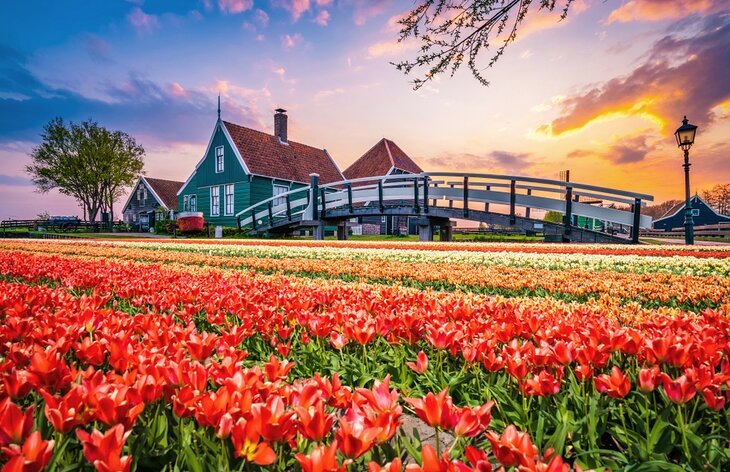
The Zaanse Schanse Open-Air Museum is a convenient place to visit for tourists who want to see windmills in excellent condition but are short on time. It offers an excellent overview of the history and significance of windmills in the Netherlands.
The windmills here were relocated to the museum grounds and carefully restored, and many still operate as functioning mills and homes. The most famous windmill in Zaanse is The Cat (De Kat), built in 1646 to process dyes; it is the only one of its kind still in operation.
While in Zaanse, be sure to visit some of its unique museums, including a bakery museum (Gecroonde Duyvelzater), the Zaan Time Museum, and the local heritage museum (Zaans Museum), among others. Tourists can also take a lovely boat tour on the Zaan that provides great views of the windmills.
Address: Schansend 7, 1509 AW Zaandam, Netherlands
Keukenhof Gardens
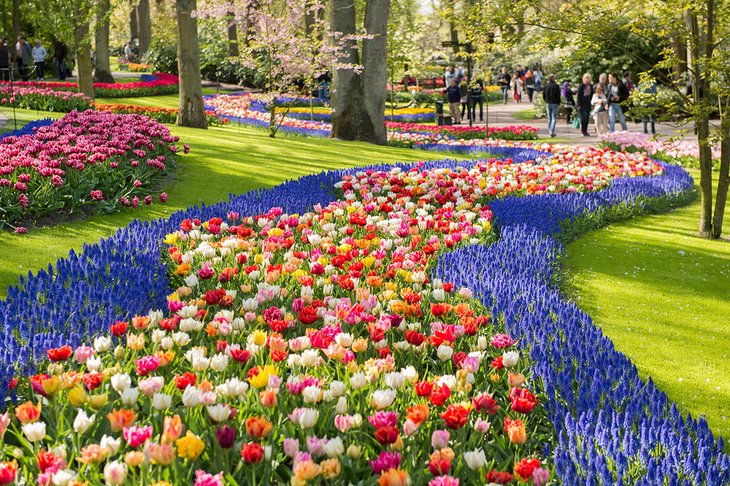
Keukenhof Gardens, located near Leiden, is the most visited destination for flower lovers, with more than seven million blooms each year. This is the world's largest public flower garden, covering more than 70 acres and growing over 700 varieties of tulips. Visitors will also find daffodils, crocuses, and hyacinth among the gardens.
The majority of the Netherlands' tulips are grown in the Flevoland Province, and mid-April through May is the best time of year to catch them in full bloom. Commercial flower-producing fields can be found along the northwestern coast of the Netherlands, occupying the swath of land between Alkmaar and The Hague.
Tourists who aren't visiting the Netherlands in the spring will still have an easy time finding tulips and other flowers thanks to indoor growing, and the collections at Keukenhof can be admired year-round.
De Haar Castle & Utrecht
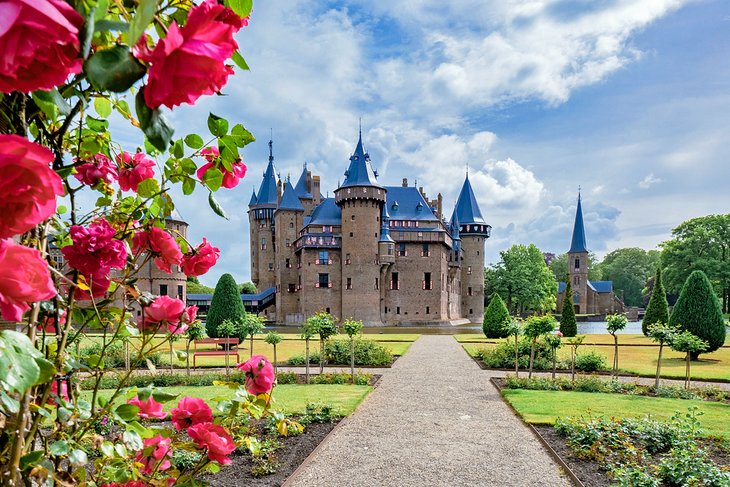
One of the Netherlands' most famous castles is De Haar Castle (Kasteel de Haar), built in 1822, near Utrecht. Its fame is not due to its age but its size and grandeur—it's infamous for displacing an entire village to make room for its construction. This fairy-tale castle can be toured, and the 135-acre property holds numerous events throughout the year, including a Christmas festival.
While in Utrecht, be sure to stop by St. Martin's Cathedral, also known as Dom Church (Domkerk). Built in 1254, this cathedral features its original Romanesque elements, as well as a 14th-century choir and transepts from the 15th century. There is also a 14th-century cloister and a lovely tea room on-site, and you can get great views by climbing the Domtoren (Dom Tower), which was once part of the cathedral.
Kasteel van Breda
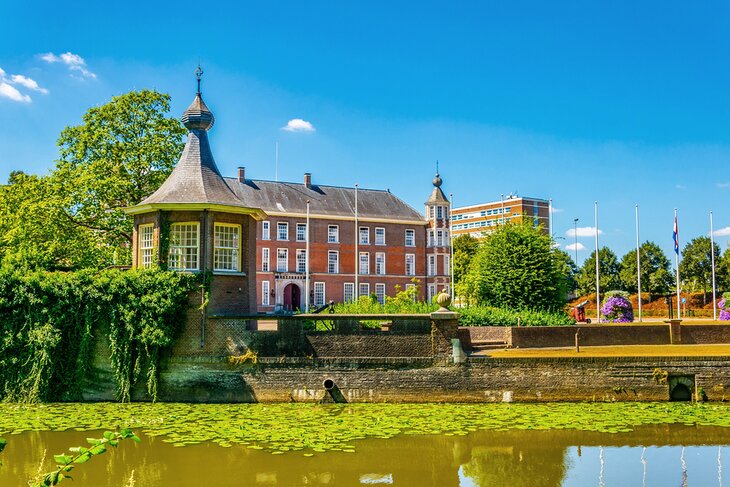
Located in the center of Breda is the UNESCO-listed Kasteel van Breda (Breda Castle), an impressive palace that has housed aristocracy and royalty since the 12th century. The current structure was built in 1530 as a fortified castle and then expanded over the centuries to its present state.
It has been home to the Royal Military Academy for the last two centuries, but prior to that it was the seat of the highly influential Nassau family. Visitors can take a guided tour of the castle, which includes a look at its massive library and its twin towers named Blokhuis and Spanjaardsgat (Spaniard's Hole).
Just south of the city, Bouvigne Castle is another beautiful royal palace with ties to the Nassaus. Built in 1554, it is best known for its variety of meticulously tended gardens.
Read More: Attractions & Things to Do in Breda
Arnhem and the Netherlands Open Air Museum
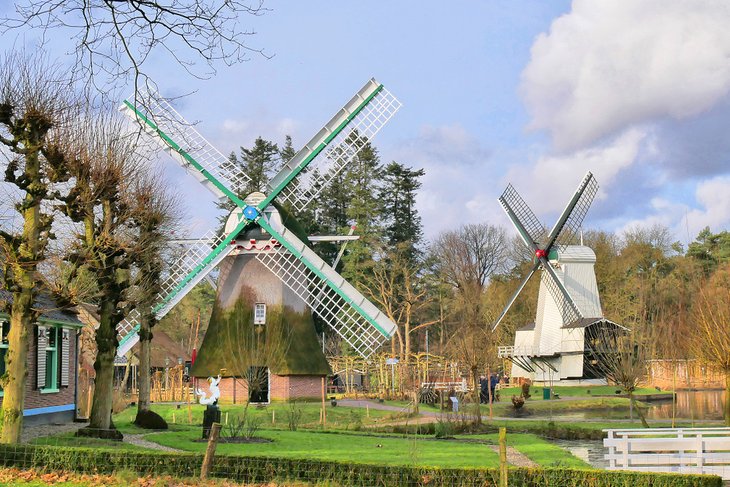
One of the Netherlands' most popular places to visit is the Netherlands Open Air Museum (Nederlands Openlucht Museum) located just outside the city of Arnhem.
This living history museum was established in 1912 to preserve Dutch history and culture, and it includes a variety of traditional homes, workshops, and windmills for guests to tour. Costumed interpreters demonstrate what daily life looked like in centuries past, including the life of fishermen, farmers, and craftsmen.
In addition to centuries-past experiences, a series of "laborer's houses" demonstrate the daily life of the average family during four distinct time periods from 1870 through 1970. In addition to the fully immersive historic village, tourists can also enjoy multi-media exhibits and ride an antique tram. The museum also hosts special events throughout the year.
Arnhem is home to several other museums, including two dedicated to remembering the struggles and sacrifices of World War II. The Arnhem War Museum and Airborne Museum Hartenstein are both fascinating, offering exhibits and guided tours that reveal what life was like during wartime.
If you're traveling with kids, be sure to leave time to stop at the nearby Royal Burgers' Zoo. This family-favorite is home to pandas, gorillas, chimpanzees, giraffes, lions, cheetahs, and rhinos. They also have a wide variety of birds, as well as a large aquarium.
Zuiderzee Museum, Enkhuizen
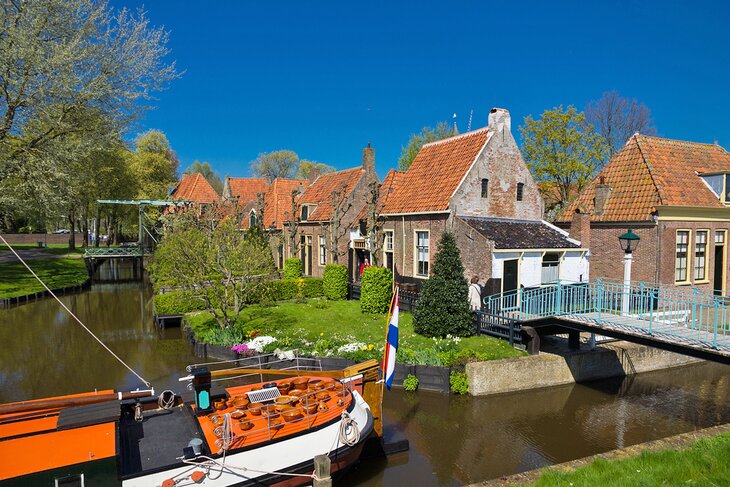
The Zuiderzee Museum in Enkhuizen gives tourists the opportunity to fully explore an old fishing village as it would have been in 1905. Highlights include participating in traditional cooking, learning about early fishing methods, and exploring the authentic "homes" of the interpreters while they describe daily life in centuries past.
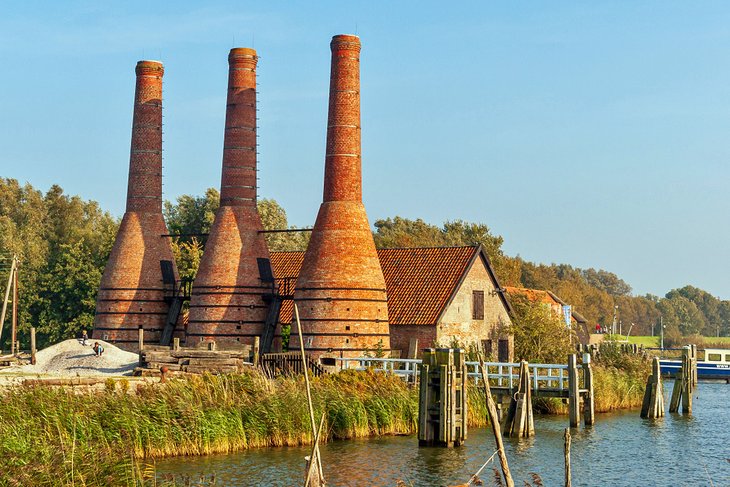
Collections range from everyday items to artwork and local crafts, as well as ships and fishing equipment. There are interactive exhibits to get younger visitors involved, too, with opportunities to dress in period costumes, explore a traditional fishing boat, and play educational games.
Groningen
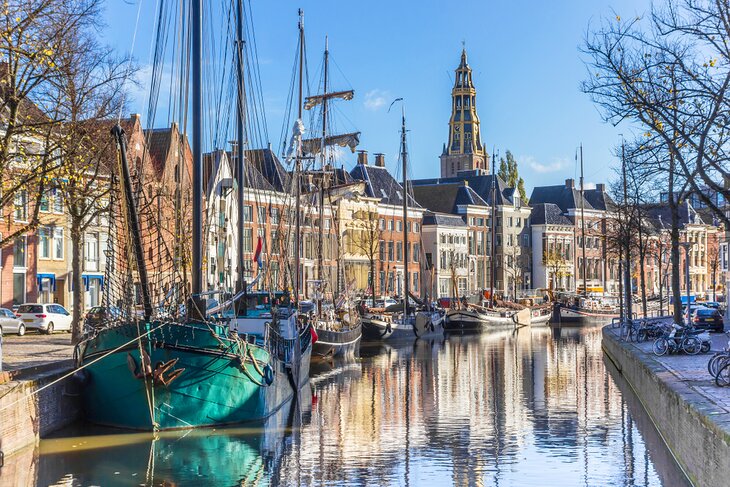
The Dutch city of Groningen is a picture-perfect spot located 20 kilometers from the North Sea, connected by two major canals that helped it thrive as a center for trade. It's also known for its rich cultural scene, hosting several art and music festivals throughout the year, and is full of excellent restaurants and lots of shopping.
Historic Buildings: It's also, of course, home to plenty of historic buildings that will please photographers and architecture aficionados. A walking tour of the Old Town district is a great place to start, and you can't miss Martinikerk (Martin's Church) with its Romanesque-Gothic exterior and vaulted Gothic choir. The tower stands 96 meters above Groningen's Grote Markt (Market Square) and can be climbed for excellent views.
Museums: Groningen is also home to an excellent art and history museum, the Groninger Museum, as well as the University Museum, which has exhibits about a wide variety of topics. The Northern Shipping Museum is a must-see for tourists interested in the area's maritime history.
Read More: Attractions & Things to Do in Groningen
Hoge Veluwe National Park
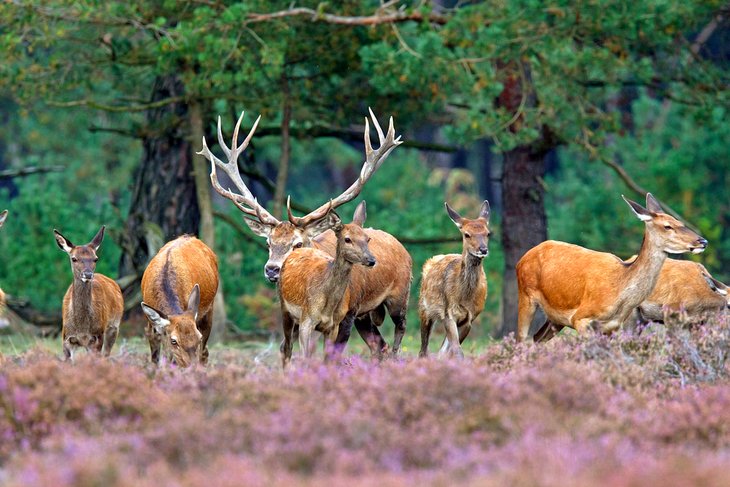
The largest nature park in the Netherlands is the Hoge Veluwe National Park, covering 13,750 acres in the center of the country, just eight kilometers from Arnheim. Originally intended as a hunting park, this privately owned nature reserve is a protected home for a wide variety of animals, including wild boar; deer; birds; and the rare mouflon, a breed of wild sheep.
Visitors can easily explore the park's huge system of trails and paths via foot or bicycle. Park routes are well-marked and offer mostly level terrain for easy passage. The park is also home to the Kröller-Müller Museum, which features an art gallery and sculpture park.
Read More: Exploring Hoge Veluwe National Park in The Netherlands: A Visitor's Guide
Oostvaardersplassen Nature Reserve
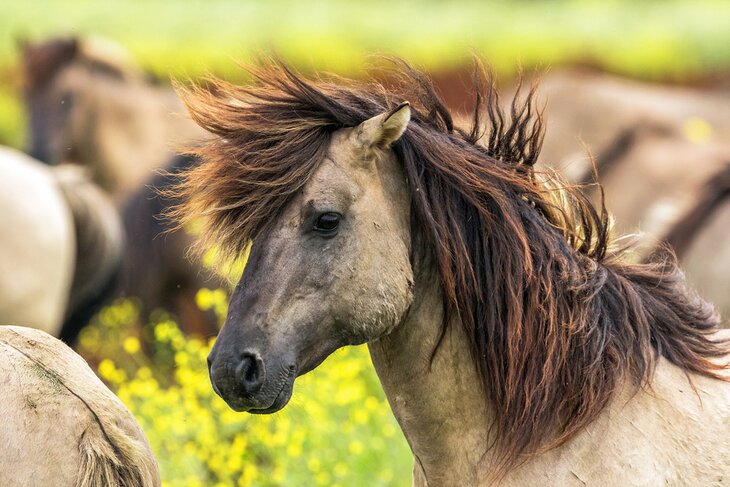
One of the most photogenic places in the Netherlands, Oostvaardersplassen Nature Reserve is located about 50 kilometers from Amsterdam. It covers an area of around 56 square kilometers along the coast of the Markermeer and is dedicated to encouraging the regrowth of forests and habitats for indigenous wildlife.
Many tourists come to admire the birds that make the wetland area their home, including egrets, black storks, cormorants, geese, white-tailed eagle, and other species that nest and feed in the reeds.
In the drier areas of the park, visitors will find Konik Horses, a wild breed that originated in Poland, as well as Heck cattle and red deer.
Volendam
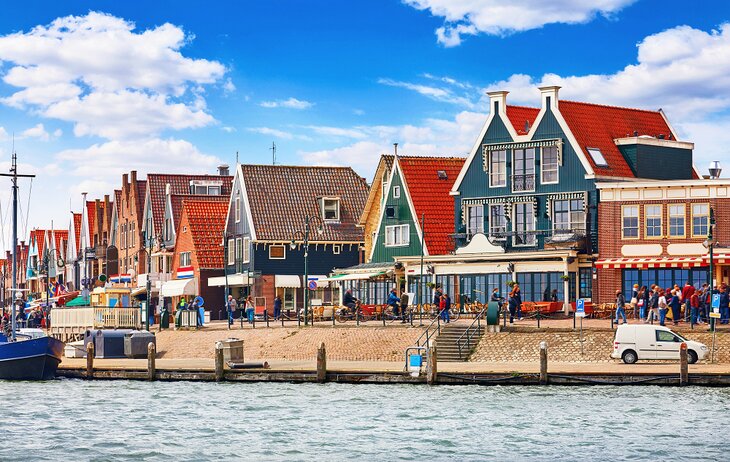
Located about 20 kilometers from Amsterdam on the shores of the Markermeer is Volendam, another superb example of a traditional fishing village. This photogenic town offers brightly colored row houses, the small but informative Volendams Museum, and historic ships in the harbor.
Nearby, the smaller but lovely village of Marken sits on a peninsula, offering an even more authentic experience. Both of these villages can easily be visited in a day trip from Amsterdam.
Vincent Van Gogh House Museum, Zundert
Another popular place to visit for true Van Gogh admirers is Zundert, the village where Vincent Van Gogh was born. Although his family's original home no longer stands, its garden remains, and the Vincent Van Gogh House Museum now occupies the spot.
Visitors will be introduced to the master's life with a multimedia presentation, and then have the opportunity to see many of his original works. The museum also includes collections of work inspired by the prolific artist, much of which is produced by artists-in-residence nearby at the Kosterswoning.
Since Vincent grew up in Zundert, there are several places associated with him, including a statue of the artist in front of the Old Dutch Reformed Church where his father once preached. There is also a cemetery where his older brother, bearing the same name and birthdate as the artist, was laid to rest after death in infancy.


